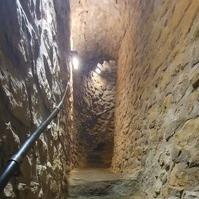Photo. Inside the Bock Casemates. © Travel Explorations.
In times of war, soldiers and civilians used these hidden exits to flee danger or move between sections of the fortress without being caught or hit by bombs.
These routes weren’t just clever – they were lifesaving. Built with purpose, carved with precision, they reveal just how smart and strategic this underground world was.
Luxembourg’s location in the heart of Europe has always been both a blessing and a curse. Sitting on key trade and military routes, it became a prize that many armies wanted to claim. Over the centuries, Luxembourg City was attacked, invaded, and rebuilt more times than most places could endure. This was my gateway to really understand how Luxembourg once stood strong through conflict and time.
From the 16th to the 19th century, Luxembourg was one of Europe’s greatest fortified sites, constantly reinforced as it passed through the hands of the Holy Roman Emperors, the House of Burgundy, the Hapsburgs, various French and Spanish kings, and, eventually, the Prussians. These have all left archaeological and cultural marks in the various gates, bastions, and forts. The historical part of Luxembourg City has also kept its original layout and public buildings.
The mighty fortress of Luxembourg - especially the Bock cliffs and its surrounding walls - endured wave after wave of conflict. Burgundians, Habsburgs, Spaniards, Prussians, and French forces all fought to control it, each leaving their mark.
Listed as a UNESCO World Heritage Site, these underground tunnels carved into the rock bear witness to the fortress city’s turbulent past. Enjoyed stunning views of the lower town through the many openings and loopholes. Got fascinating insights into the strategic importance and the secrets of this impressive part of the fortress.
Luxembourg City’s has an unique geography as Ville-Haute (Upper Town), the Bock Casemates and three of the “lower” quarters known as Grund, Clausen and Pfaffenthal.
The origin of the word “casemate” is not clear. Possibly it derives from “chasma(ta)”, Greek for “crevice” or “gap in the earth”.
Dramatic history and legends, secret corridors and rooms.
In the 20th century, war struck again. Germany invaded Luxembourg during both World War I and World War II. In the second war, the city also faced Allied bombing raids. During these terrifying attacks, the vast network of tunnels beneath the city became life-saving shelters, hiding up to 35,000 people at a time. Through all this, Luxembourg endured - a small nation that has stood in the crosswinds of Europe’s history.
The Bock Casemates stretch like a hidden world. Built and expanded by Spaniards, French, Austrians, and Prussians, their true beginnings remain unclear. Some tunnels are known, others lost to time. Whispers tell of secret passages, hidden chambers, and unseen levels waiting in the dark. Even today, no one knows how far they reach - or what still lies beyond. Some passages are mapped, others swallowed by time. Rumors speak of hidden chambers, sealed doors, and entire levels yet to be found. Many believe treasures - relics of war, lost riches, or secrets of the city - lie buried in the darkness, waiting for the one who dares to uncover them.
Walking there, I couldn’t help but imagine the fear, the courage, and the quiet footsteps of those who once depended on these dark paths to survive.
Sometimes I felt almost lost in the enormous tunnel complex, but finally I found my way out - for a fresh breath. Emerging back into daylight, I realised the Bock Casemates are more than stone and tunnels. They are the city’s memory, a place where the past still breathes, and where every turn holds a story.
Stein Morten Lund, 10th August 2025
Additional information












